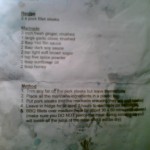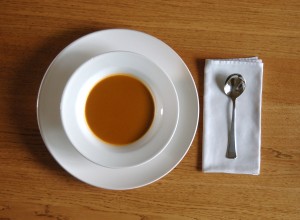I’m not sure of the provenance of this recipe, but I’m attributing it to my mate Sam, who has served it up at his and Eileen’s New Year’s Eve party for the last few years …
Feeds 20 and takes 24 hours to cook, not suitable for vegetarians or other anomalies on the gastro-continuum.
Method:
First, order up the shoulder of pork. You need a 10kg piece, and it may be called something different in your neck of the woods, possibly a forequarter of pork. Ask the butcher to score the fat. Let it come to room temperature while you make the rub. And turn on your oven full blast, as high as it’ll go within reason, say 250C.
Aye, there’s the rub:
You’ll have plenty of opportunity to sleep: perchance to dream with this recipe since it takes a full 24 hours to cook (note the literary reference for all you Shakespeareans out there). For the rub, mix some garlic (say about 8 cloves), a teaspoon or more of chilli flakes, a large knob of peeled fresh ginger, a tablespoon of wine vinegar and two of olive oil together. Chuck it all into your biggest, baddest mortar and pestle and pound to oblivion. The proportions are a little vague, but make enough paste to cover the meat, rub it into the scored fat especially. Use your hands for this, since it’ll put you in touch with your animal self. Keep a little of the rub back for later.
Next, stick your smeared joint on a rack, skin side up, and slide into the blazing oven. It’s surprising how heavy 10 kilos feels while your arms are extended, so if you’re weak or faint of heart, get somebody stronger to do it for you.
After about half an hour to 40 minutes, by which time your kitchen will be smelling glorious, remove the beast and, using oven gloves or similar, turn the cut the other way, skin side down, and mash the remaining rub into the exposed side.
Turn your oven down very low, say 120C or gas mark 1/2, put the shoulder back into the oven and cook for a long time. About a day. The slow oven in your Aga would be perfect for this. You can’t overcook the meat at this temperature, so it doesn’t matter if it’s a bit longer.
Finishing:
About half an hour before you want to eat, crank the oven back up high again, turn the meat skin side up and blast with heat for perfect crackling. Then serve. It will probably fall apart on the platter, so carving isn’t really the operative word, more like pulling or rending. Pour off the fat and make a gravy with what’s left at the bottom of the roasting tin. Serve with red cabbage and a celeriac mash.
Thanks again, Sam.
Addendum:
After a modicum of googling, it would appear that this recipe is from the toothsome Nigella, who in turn borrowed it from the second River Café Cookbook, and God only knows where it came from before that. So I don’t feel lazy or guilty (just hungover) because neither Sam nor I will ever be as beautiful or rich as Nigella, and it wasn’t her idea anyway.








